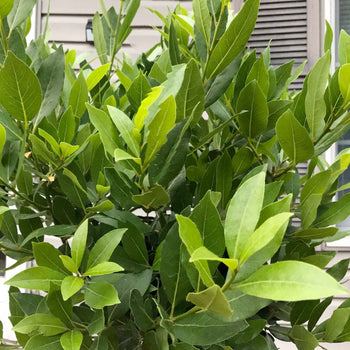
Season: All Year
Looking for a Specific Herb?
Search Our Herb Almanac Below:
|
|
|
Bay leaf, also known as Laurus nobilis, is an aromatic evergreen tree or shrub native to the Mediterranean region. Its glossy, dark green leaves are widely used as a culinary herb, imparting a subtle, savory flavor to various dishes such as soups, stews, and sauces. Dried bay leaves are more commonly used than fresh, as their flavor intensifies during the drying process. Aside from culinary applications, bay leaves hold historical significance in ancient Greece and Rome, symbolizing victory and honor. Additionally, they possess medicinal properties, including anti-inflammatory, antioxidant, and digestive benefits. When cooking, bay leaves are typically removed before consumption, as their edges can be sharp.
|
 |

Mature Height
48 Inches |
 |

Mature Width
36 Inches |
 |

Light
Sun |
 |

Water
Low |
 |
|
Uses
Bay leaves were used for flavoring by the ancient Greeks. They are a fixture in the cooking of many European cuisines (particularly those of the Mediterranean), as well as in the Americas. They are used in soups, stews, brines, meat, seafood, vegetable dishes, and sauces. The leaves also flavor many classic French and Italian dishes. The leaves are most often used whole (sometimes in a bouquet garni) and removed before serving (they can be abrasive in the digestive tract). Thai and Laotian cuisine employs bay leaf in a few Arab-influenced dishes, notably massaman curry.
Bay leaves can also be crushed or ground before cooking. Crushed bay leaves impart more fragrance than whole leaves, but are more difficult to remove and thus they are often used in a muslin bag or tea infuser. Ground bay laurel may be substituted for whole leaves and does not need to be removed, but it is much stronger.
Bay leaves are also used in the making of jerk chicken in the Caribbean Islands. The bay leaves are soaked and placed on the cool side of the grill. Pimento sticks are placed on top of the leaves, and the chicken is placed on top and smoked. The leaves are also added whole to soups, stews, and other Caribbean dishes.
|
 |
|
RECIPES
Bistek With Onion and Bay Leaves
Ingredients
* 2 1-inch-thick boneless rib-eye steaks, excess fat trimmed
* 2 tablespoons vegetable oil, divided
* 8 fresh bay leaves
* 1large white onion, sliced into ½-inch-thick rounds
* ¼ cup fresh lemon juice
* ¼ cup soy sauce
* Kosher salt
Preparation
Step 1: Slice steaks in half lengthwise. Following natural seams in meat, cut each half into 2–3 pieces and set aside.
Step 2: Heat 1 Tbsp. oil in a large skillet over medium. Add bay leaves; cook until beginning to brown around the edges, about 1 minute. Add onion and ½ cup water. Cover skillet (use a baking sheet if you don’t have a lid) and cook until onion is partly tender; it should have lost its raw bite but still have some crunch, about 5 minutes. Transfer onion and bay leaves to a plate with a slotted spatula or tongs.
Step 3:Increase heat to medium-high and bring remaining liquid in skillet to a boil. Cook until only 2 Tbsp. remains. Scrape into a small bowl and stir in lemon juice and soy sauce. Set sauce aside.
Step 4: Wipe out skillet and heat remaining 1 Tbsp. oil in skillet over medium-high. Season reserved meat with salt. Working in batches, cook meat undisturbed until dark brown, about 2 minutes. Turn and cook until second side is lightly browned, about 45 seconds. Transfer to a platter.
Step 5: Reduce heat to medium (let skillet cool a little if it is very hot) and cook reserved sauce in skillet just to let flavors meld, about 1 minute. Add 1–2 Tbsp. water if sauce is too concentrated. Pour over meat and top with onion and bay leaves.
|
|






















